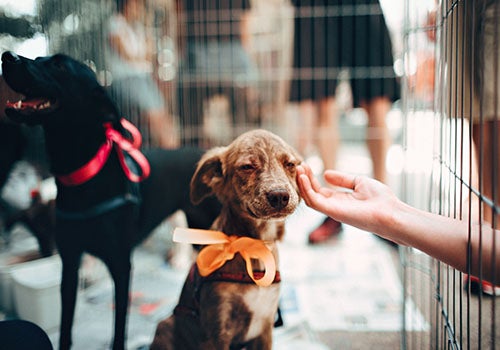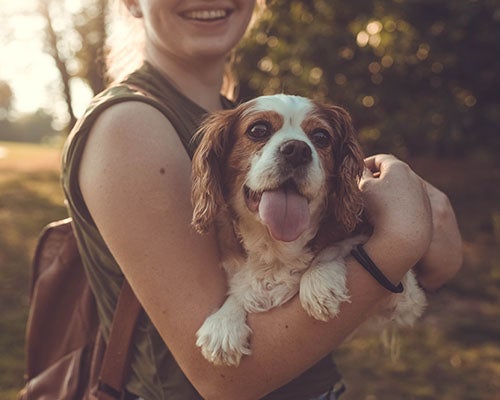January 10, 2020
Looking to Adopt a Dog? Here’s Where to Start!
There is a good reason that dogs are called man’s (and woman’s) best friend. From the moment you bring your new dog home, he will spend his lifetime striving to be your biggest fan, most ferocious protector, snuggliest couch cuddle partner, and honorary child in your family portraits. And whether it’s a wriggling new puppy that joins your pack or a senior dog celebrating his third act by leaving the animal shelter to become part of your family, your new dog will ultimately end up being your best friend. But bringing a dog into your life isn’t a matter to be taken lightly; you are making a commitment for that dog’s whole life! If it’s your first time looking to adopt a dog, you might need a few pointers on where to start!
1. Make Sure You’re Truly Ready

“Owning a dog is a big responsibility.” We’re sure you’ve heard those words before when you were a kid trying to convince your parents that you were ready for one of the squirmy pups in the box marked “Free Puppies.” But even as an adult, it’s true. A dog takes time and money, and you need to make sure you have enough of both before committing to a new pet.
Consider your lifestyle; do you have time to take a dog for a walk a few times a day (or pay someone else to do it for you while you’re at work)? Do you have time to visit the dog park on weekends, to throw a ball with your pooch in the yard, or to simply sit petting your dog regularly? And for the financial side, do you have the funds for required and recommended vaccinations, quality food, boarding fees when you’re out of town, extra cash for travel fare when flying with your dog? Deciding to bring home a new dog is a long term decision, a lifelong decision for your dog, so make sure you are truly ready and capable.
2. What Breed To Look For When Adopting A Dog
It is said that some people look like their dogs, and while that may not always be the case, it is unquestionably true that there are certain breeds for certain people. Do you have an active lifestyle? Choose a sporting dog, or working dog, who have lots of energy and need an equal amount of time for exercise. Do you have an allergy to dog hair or dander? Look for a hypoallergenic breed that doesn’t shed. Have a small apartment and not a big yard for running? Consider a toy breed, who can get their exercise by throwing a ball in your living room.
Have small children? Consider more patient, cuddly breeds, like the Golden Retriever, known for being true family dogs. But beyond researching the breed, once you have found the dog you think is for you, research that particular dog. Sure, new puppies don’t have much history, but that sweet, earnest face peering at you from behind the sign marked ‘Mixed Breed, Approx. 5 Years Old’ at the animal shelter?
That dog has a past, and while you may never know everything there is to know about where he’s from or what he’s experienced, you can spend some time with him before bringing him home. Some rescue dogs will require extra love, attention, medical care, training, or therapy, but they will be worth every moment. But be fair to yourself and the dog by knowing as much as you can before saying ‘yes,’ so that you can be as prepared as possible.
3. Prepare Your House and Family

Sure dogs are going to chew and have accidents in the house before they are housebroken, but since you know that, you can’t completely fault your animal if something irreplaceable is damaged, or if your new rug now requires a $150 cleaning to remove some, ahem, stinky stains.
Prepare your home for your dog’s arrival by removing or securing dangerous objects (poisonous plants, small choking hazards, exposed electrical cords, household cleaning supplies and chemicals), storing precious items that cannot be replaced, and creating barriers to keep your pooch contained to safe, dog-friendly zones, using dog gates or closed doors.
Also, prepare your family, especially if you have small children, by explaining your new dog’s needs and boundaries and giving everyone a chance to commit to their part in the care of your dog, including walking, bathing, feeding, and of course, showering with love and affection.
4. Stock Up On The Right Supplies
Just like any member of your family, your new dog will have basic needs, including food, water and shelter, and the choices you make for these items can contribute heavily to your dog’s overall quality of life. Make sure there is constant access to water (unless recommended otherwise by your vet) and changing that water frequently is a must.
Quality food is imperative, and choosing a diet based on your specific dog’s breed and health requirements is easy when you know where to look (hint, hint). Of course, Wellness Pet Food offers delicious food for cats and dogs, and quality ingredients are at the basis of everything we do. Lower quality dog food made with fillers and byproducts? That’s like going through a drive-through every single day for fast food. Would you do that for yourself? Of course not!
So give your dog a better life with better food. And finally shelter; will your pooch live indoors or outdoors? If outdoors, make sure he is in a secure area with a tall enough fence or enclosure and can easily access his own space out of the elements, one that will stay warm enough in the winter and cool enough in the summer.
5. Spend Some Quality Bonding Time

Finally, make sure you can spend a good amount of quality time with your new dog when you bring him home. Plan his arrival around a weekend, a school vacation, or even take a few days off work. Give some thoughtful planning to how you will spend your first days together, making sure he knows that he is safe and loved. And, of course, now is a good time to get started on tricks! Even old dogs can learn a few tricks, too. Most of all, enjoy your new friend. Because, as they say, dogs may not be our whole lives, but they do make our lives whole.
Visit our Wellness Foundation partner Best Friends Animal Society to search adoptable pets in your area. #RaisedWithLove





